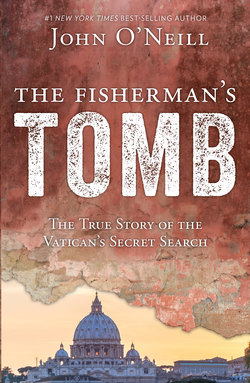Читать книгу The Fisherman's Tomb - John O'Neill - Страница 14
На сайте Литреса книга снята с продажи.
ОглавлениеChapter Four
The Great Fire of Rome
(July 18–19, A.D. 64)
The monster Nero ruled the Roman Empire from A.D. 54 to 68. He is most notable to history for his unbelievable cruelty. It is rumored that he was involved in the poisoning of his adopted father (in order to become emperor) and joked about it.29 He executed his own mother and his wife. He is said to have poisoned his brother and personally killed his pregnant second wife by kicking her to death.30 Nero unleashed a sea of blood in the city of Rome, not sparing any class or person. He was famous for his cowardly pretensions and even awarded himself first place in an Olympic chariot-racing competition — even though he had dropped out of the race. He was a poor singer whose most notable song is said to have played while Rome burned. He was the last of the great dynasty started by Julius Caesar, a dynasty once much loved by the Roman people. Nero’s reign was marked by notable military triumphs and distributions of food, treasure, and wealth to the people of Rome. But his cruelty and evil madness made him much-hated in Rome. In A.D. 68 he would be driven from power, unable to find a single friend to shelter him. Ironically, he would, like Adolf Hitler in the twentieth century, exit this world with a cowardly suicide while still proclaiming his own greatness.
In the hot summer of 64, Nero planned to build the largest palace in human history in the crowded center of Rome. In addition to a large lake and gardens, he planned to construct a massive, 100-foot statue of himself, the so-called Colossus Nero, portraying him as the sun god with a rudder steering the world under his feet. To build his palace he needed land — lots and lots of land — in the densely populated center of Rome, a city of a million or more and at the time the largest city in the world.31
Thus the Romans and most of their contemporary historians believed it no coincidence when, on the evening of July 18, 64, a massive fire broke out in many different shops southeast of the Circus Maximus. It was an extraordinarily hot night, even for Rome, with high winds blowing. The fire rushed up Rome’s fashionable Palatine Hill, destroying the most ancient parts of the city. The ancient temple of Rome’s patron god, Jupiter, burned, along with the Forum. The fire also reached the Subura District crowded with wooden, multistory apartment houses. The fire burned for six days and seven nights — in the end damaging or completely destroying ten of the fourteen districts of Rome.32
Reports of fires set by systematic arsonists swept through Rome. Nero claimed much of the destroyed area for his grand palace, leading Romans to suspect that Bloody Nero himself, despite his hypocritical protestations of concern for the victims, had set the Great Fire.33 To save face, Nero (like Hitler centuries later) settled upon a small, unpopular cult to blame for the fire.34 The Christians, who worshipped as God an alleged criminal executed by the Romans, were a perfect target. Nero unleashed upon the Christians an incredibly cruel persecution, even by ancient standards.35
The place of their torture and execution was Nero’s gardens and circus, built in anticipation of the grand palace, known as the Domus Aurea — the Golden House.36 He had the Christians (men and women) dipped in oil and then wrapped in flammable cloth and materials, hoisting them in the air on posts and burning them alive as human candles to light his gardens. He sewed women and children into animal skins and released dogs to tear them apart. He crucified Christians by the hundreds, sometimes upside down. Even hardened Romans like the historian Tacitus found his treatment of the Christians extraordinarily cruel.37 His cruelty apparently did not offend the large, cheering Roman crowds.
Christian tradition and later writings relate that during this persecution Nero located, condemned, and executed the two great leaders of the early Christian Church — Peter and Paul.38 These traditions hold that Peter, after long, horrible imprisonment, was crucified upside down, at his request.39 He did not consider himself worthy to die as Jesus had. Tradition further relates that the Roman executioners discarded Peter’s body on the ground on a nearby, vacant hill used as a dumping ground for waste, but that Christians secretly recovered and buried Peter’s body on that hill.40 The traditions claimed the site became almost immediately a secret place of worship for the Christians. The name of that place was Vatican Hill.
